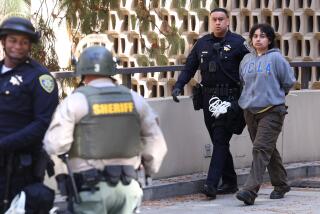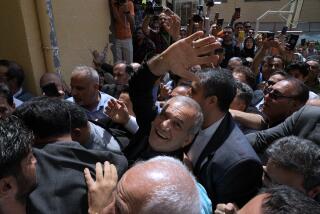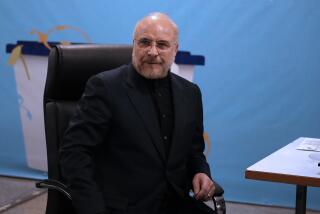Iran streets and campuses erupt in protest
Reporting from Beirut — Campuses across Iran erupted in protests Monday as defiant college students chanting anti-government slogans clashed with security forces armed with clubs in a forceful new round of confrontations over the nation’s disputed June presidential election.
The daylong protests on National Students Day were not as large in Tehran as those that broke out in the days after the reelection of President Mahmoud Ahmadinejad. But they took place in a larger number of cities and towns and followed weeks of ominous warnings by security officials. They continued through the day despite efforts by security forces arrayed on streets and inside campuses.
Outside Tehran, the first large-scale civil unrest since early November broke out in ethnic Kurdish and Azeri regions, which have often clashed with the Tehran government. Those areas had thus far been relatively quiet in the election protest movement dominated by middle-class urbanites.
The protests received wide international coverage despite a government ban on foreign media and large-scale filtering of websites and the shutting down of some telecommunications services.
“Students were really brave,” said one Iranian journalist who covered the events for the local reformist press. “They said all they needed to say today. The way ahead is long. But the goal is achievable.”
But the protest movement born out of the disputed election loss of former Prime Minister Mir-Hossein Mousavi appears to have grown more radical. Fewer of the slogans were aimed at Ahmadinejad and more at Iran’s theocracy-based political system, a shift that could alienate potential opposition supporters but also further galvanize protesters and serve to destabilize the Islamic Republic.
“I take to streets to protest because I want change now, not tomorrow,” said one young female protester. “I am fed up with the current situation.”
Some Iranian leaders appeared to recognize the risk of a grass-roots movement devoted to reforming the government becoming a hardened opposition dedicated to overthrowing it.
“A large number of people formed the majority in the elections and another large number of people the minority,” said Grand Ayatollah Nasser Makarem Shirazi, a prominent cleric, according to the Iranian Students News Agency. “We should sit together and negotiate and the precondition to that is the creation of a calm atmosphere.”
State television and radio dismissed the protests as insubstantial. The Fars News Agency, which is close to Ahmadinejad and the hard-line Revolutionary Guard, reported that 2,000 pro-government activists took to the streets in the capital on the day designated to commemorate a deadly 1953 crackdown on a protest against Iran’s former monarch.
“This year’s demonstrations were more glorious than ever before,” a presenter on state television declared.
But amateur videotape posted on the Internet showed thousands of anti-government students chanting slogans and gathering on various campuses around the country. Credible reports of protests emerged from campuses in the central Iranian cities of Esfahan, Shiraz and Kerman, in the eastern city of Mashhad and in the western cities of Tabriz, Kermanshah, Hamedan and Ilam as well as in Rasht on the Caspian Sea.
Arrests reported
Witnesses and Iranian news sources also reported numerous arrests, including those of Majid Tavakoli, a student leader who was hauled away after delivering a speech at Tehran’s Amir Kabir University, and two Iranian journalists reportedly filming the protests for foreign television stations, Iranian media reported.
Iranian security forces had been cracking down in anticipation of the demonstrations, arresting student activists and warning others against taking to the streets to mark the 1953 protest during a visit by then-Vice President Richard Nixon. His trip followed a Washington-bankrolled coup d’etat that overthrew the democratically elected government of Prime Minister Mohammed Mossadegh and reestablished the absolute rule of monarch Mohammed Reza Shah Pahlavi.
The day was traditionally marked by pro-government rallies but has been co-opted by reformist student groups since a 1999 uprising. In the hours before Monday’s protest, pro-government Basiji militiamen had been allowed to flood university campuses in an attempt to inhibit the protests.
Some students had vowed to turn the occasion into an anti-government protest, as activists have done during other recent state holidays. The protesters mobilized for weeks, plastering Tehran walls with placards and specifying routes and meeting locations in e-mails and on the Internet.
Opposition leader Mousavi, who lost to Ahmadinejad on June 12 in balloting critics described as rigged, called on followers to take part in Monday’s protests.
“They ask us to forget about the election results as if the problem is only the elections,” Mousavi said in a recent statement published on the Internet. “The problem of our people is not who the head of the government is or who is not. The problem is that this few are bolstering their egos to the shame of a great nation.
“You fight people on the streets,” he added, “but you are constantly losing your dignity in people’s minds.”
Pro-government militiamen and uniformed security forces, often spotted mingling with one another, began confronting students early in the morning. Huge phalanxes of security forces could be seen along downtown Tehran streets as the skirmishes continued into the late afternoon.
Witnesses reported plainclothes security forces on motorcycles, watching for protesters on public buses and ordering backpacks opened in search of cameras and political placards or insignia.
As the afternoon skies turned overcast, police and plainclothes militiamen could be seen beating fleeing demonstrators and hauling them away. Police shot tear gas canisters at protesters who chanted “Death to the dictator” and set garbage bins on fire.
But security forces refrained from using deadly force, perhaps to avoid repeating history. It was the monarchy’s heavy-handed slayings of protesters in 1977 and 1978 that helped build up the momentum for the revolution that established the Islamic Republic the following year.
‘Don’t be afraid!’
The number of protesters heading to the streets appeared to increase as the day wore on, despite the security measures.
Amateur footage sent via e-mail showed overwhelmed plainclothes militiamen on one campus stepping to the sidelines and videotaping the protesters.
“Don’t be afraid! Don’t be afraid!” they chanted. “We are all together.”
Video footage also showed students unfurling banners of green, the color of the protest movement, as they marched through campuses and poured into the streets to hurl rocks at security forces. Protesters pummeled at least one Basiji militiaman who had been beating a woman. Passing motorists honked their horns in support of the protest, creating a deafening shriek that could be heard all over central Tehran.
“This is the price for freedom,” said one young man in his mid-20s as he nursed an arm badly bruised by what he said was a police truncheon. “Our friends in jail are on hunger strike. I cannot help protesting. I simply have to do something.”
Security forces appeared to be monitoring downtown buildings to make sure protesters couldn’t take refuge in them. Office workers often provide shelter to the young demonstrators. But huge clouds of tear gas burned the eyes of police as well as protesters and passersby, and some joined in seeking shelter from the chaos.
“We are tired, exhausted and this is not going to end soon,” said one police officer who stumbled into a downtown office building and asked for a cup of tea and a cigarette.
He added, “I swear to God, I have not beaten anyone.”
More to Read
Sign up for Essential California
The most important California stories and recommendations in your inbox every morning.
You may occasionally receive promotional content from the Los Angeles Times.










